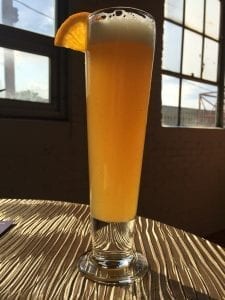It’s the first day of summer and the hot, humid air is buzzing with life. You can smell the freshly cut grass in the distance, the aroma following the hum of a lawnmower that grows then fades on a soft breeze, rustling the leafy trees. The only addition that could make this moment better, you think to yourself, is an ice-cold beer in your hand. Can, glass, bottle–you don’t care–as long as it’s refreshing.
You can make your way to the store, saunter over to the refrigerated shelves and shelves of beer, and peruse the many options available at your fingertips. It’s simple to find a flavor you think you might like–a grapefruit IPA, or maybe an imperial stout–crack it open once you reach your porch and take a promising swig. But what will truly satisfy you? Which beer style in that vast selection can quench that late-summer thirst?
Lucky for you, the answer to all your summer beer questions dominates the current commercial beer market in America and has dominated the German beer market for over 30 years. Have you guessed it yet? I’m talking about the pilsner, the crystal clear, golden beverage that changed the global beer market since its creation in Plzen, Pilsen in English, located in Bohemian Czech Republic. Don’t get me wrong, though; the versions of commercial pilsners that Americans are accustomed to drinking are nothing like the original Pilsner Urquell distributed for the first time in Bohemian Czech on November 11, 1842.

The OG Pilsner
It’s easy to forget in today’s world that food not indigenous to our homes must be preserved to travel far distances and still maintain its freshness in the store, where it awaits our arrival. Bohemian brewers prior to industrialization were limited to using local ingredients and methods of brewing that were compatible with the climate of their home; however, this is where they originally went wrong. Inconsistent brewing and product in the area instigated the people’s call in the 1830s for a brewing revolution. It was a cry for brewers to implement better practices that would cease the creation of beer that simply would not stay fresh enough to drink.
By utilizing readily available ingredients, recruiting a Bavarian brewer named Josef Groll, and borrowing the indirect heating system for kilning from the English, the very first pale lager was born. It turned out that Bohemian Czech brewers needed to flip their idea of brewing upside down quite literally, bottom-fermenting their beer instead of top-fermenting. The cooler temperatures of bottom-fermenting, synonymous with the brewing of lagers, were more compatible with their northern climate. The nineteenth-century is generally characterized by industrial growth, and refrigeration and mass produced glassware helped make the pilsner a popular selection that was easily stored as well as admired.
This revolutionary beer was considered so because it introduced a lighter-than-usual beer that was subdued in flavor with a crisp finish. The original pilsner was created with Saaz hops, a noble hop that is herbal and floral in nature, creating a pleasurable aroma and a mild to medium bitterness that has diminished substantially over the centuries. Bohemian-style pilsners are generally deep golden in color and maintain a buttery taste, but by no means does any one flavor overpower the others.

The Rival

I specify that the Pilsner Urquell is Bohemian because there was another pilsner brewer on the block: Germany. The country proficient in brewing wanted to be credited with the new beer creation, claiming that the German-run brewery should have been enough to give Germany the applause. Decades later, a German brewer, Bitburger, used the name “pilsner” to refer to one of his own beers, which resulted in a lawsuit. In 1913, it was finally ruled that the term “pilsner” is open for use despite its reference to the geographical location of its conception.
The term has variants–“pilsener,” for one–and as a courtesy, some German brewers use the term “pils” to differentiate between the styles. They are, in fact, different, despite nineteenth-century German brewers’ protests to the contrary. The German-style pilsner is lighter in both color and body, is slightly less bitter, and never reveals that Bohemian, buttery taste. The alcohol by volume (ABV) for both, however, is usually about the same: usually somewhere between four and five percent.
The latter style may be what we are typically used to seeing (and tasting) of a pilsner, a light-bodied beer that has mild aromatic hops and a clear appearance. No tricks here: what you see is what you get. The lack of a long-lasting aftertaste paired with the drinkability of noble hops and low ABV quenches your seemingly insatiable thirst and invites you to take another sip, and another!

Your Turn!
Now that I know you want to try a pilsner for sure, pour yours into a flute, the suggested narrow glassware then fans out at the mouth, to get the most of its aroma and the taste that follows. We’ve got just the right brews for that flute, suggested by your very own City Brew Tours beer guides in each of our cities. We’ve compiled a list for you folks at home to try the amazing pilsners available for selection recently in Burlington, Boston, Philadelphia, Pittsburgh, Baltimore, and Washington, D.C.
Here’s what they came up with:
Burlington
Devon: Zero Gravity Brewing Co. Green State Lager
Boston
Andy: Idle Hands Craft Ales Adelais
Philadelphia
Sam: Flying Fish Brewing Co. Exit 14
Pittsburgh
Barry: Penn Brewery Penn Kaiser Pils
Baltimore
Ryan: Heavy Seas Beer Pounder
Matt: Monument City Brewing Co. Penchant
Washington, D.C.
Steve: Port City Brewing Co. Downright Pilsner
Barry: District Chophouse Cheque (Czech) Please
References
The Oxford Companion to Beer, Garrett Oliver, Tom Colicchio
The Homebrewer’s Log Book, Cedric Rochefort